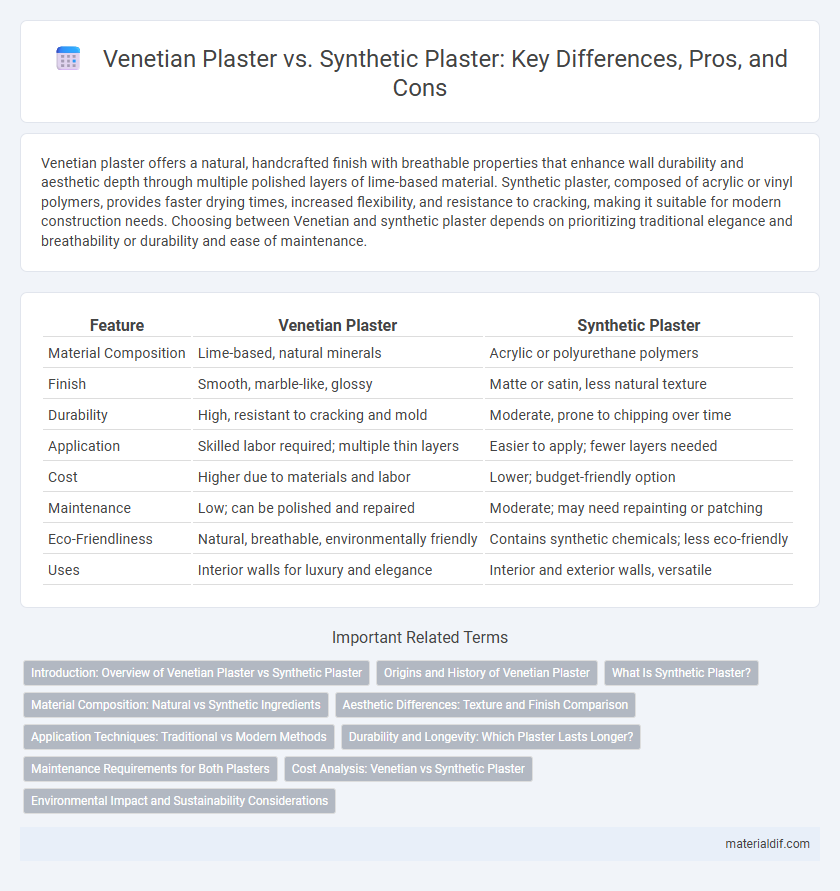Venetian plaster offers a natural, handcrafted finish with breathable properties that enhance wall durability and aesthetic depth through multiple polished layers of lime-based material. Synthetic plaster, composed of acrylic or vinyl polymers, provides faster drying times, increased flexibility, and resistance to cracking, making it suitable for modern construction needs. Choosing between Venetian and synthetic plaster depends on prioritizing traditional elegance and breathability or durability and ease of maintenance.
Table of Comparison
| Feature | Venetian Plaster | Synthetic Plaster |
|---|---|---|
| Material Composition | Lime-based, natural minerals | Acrylic or polyurethane polymers |
| Finish | Smooth, marble-like, glossy | Matte or satin, less natural texture |
| Durability | High, resistant to cracking and mold | Moderate, prone to chipping over time |
| Application | Skilled labor required; multiple thin layers | Easier to apply; fewer layers needed |
| Cost | Higher due to materials and labor | Lower; budget-friendly option |
| Maintenance | Low; can be polished and repaired | Moderate; may need repainting or patching |
| Eco-Friendliness | Natural, breathable, environmentally friendly | Contains synthetic chemicals; less eco-friendly |
| Uses | Interior walls for luxury and elegance | Interior and exterior walls, versatile |
Introduction: Overview of Venetian Plaster vs Synthetic Plaster
Venetian plaster is a natural, lime-based finish known for its elegant, polished appearance and breathability, making it ideal for high-end interior walls. Synthetic plaster, often composed of acrylic or gypsum, offers faster application and increased durability but lacks the eco-friendly and aesthetic qualities of Venetian plaster. Both materials serve distinct purposes in wall finishing, with Venetian plaster favored for luxury and authenticity, while synthetic plaster suits modern, budget-conscious projects.
Origins and History of Venetian Plaster
Venetian plaster originated in ancient Rome, where it was developed as a durable and decorative wall finish using natural lime and marble dust. This traditional technique evolved through the Renaissance, becoming synonymous with luxury and fine craftsmanship due to its smooth, polished appearance and natural composition. In contrast, synthetic plaster emerged in the 20th century as a cost-effective alternative, often composed of acrylic polymers and designed to mimic traditional finishes with quicker drying times and enhanced durability.
What Is Synthetic Plaster?
Synthetic plaster is a modern, polymer-based coating designed to mimic traditional plaster's smooth finish while offering enhanced durability and flexibility. Unlike Venetian plaster, which is made from natural lime and marble dust, synthetic plaster incorporates acrylic resins and other synthetic materials to resist cracking and moisture damage. This makes synthetic plaster ideal for both interior and exterior applications where longevity and low maintenance are priorities.
Material Composition: Natural vs Synthetic Ingredients
Venetian plaster is made from natural limestone, marble dust, and lime putty, offering a breathable and eco-friendly finish that enhances wall durability and aesthetics. Synthetic plaster consists mainly of acrylic, cement, and polymers, providing faster drying times and increased resistance to cracking but lacking the natural texture and eco-benefits of natural ingredients. The choice between Venetian and synthetic plaster depends on desired finish, environmental impact, and long-term wall performance.
Aesthetic Differences: Texture and Finish Comparison
Venetian plaster offers a rich, multidimensional texture with a natural, marble-like finish that enhances wall depth and elegance through its hand-applied, polished layers. Synthetic plaster typically has a more uniform, matte appearance with less variation in texture, providing a consistent but less intricate aesthetic. The Venetian plaster's dynamic sheen and subtle tonal shifts contrast sharply with the flat, smoother surface achieved by synthetic alternatives, making it the preferred choice for sophisticated interior designs.
Application Techniques: Traditional vs Modern Methods
Venetian plaster application involves traditional techniques such as multiple thin layers of slaked lime applied with a trowel to create a polished, marble-like finish, emphasizing hand craftsmanship and skill. Synthetic plaster uses modern methods including spray application and premixed compounds, allowing faster coverage and uniform texture with less manual labor. The choice between these techniques impacts drying time, durability, and aesthetic outcomes, with Venetian plaster favored for authentic texture and synthetic plaster valued for efficiency and versatility.
Durability and Longevity: Which Plaster Lasts Longer?
Venetian plaster, made from natural lime and marble dust, offers exceptional durability and can last for decades when properly maintained, resisting cracks and moisture effectively. Synthetic plaster, composed of acrylics or vinyl, provides greater flexibility and quicker drying times but is generally less long-lasting and more prone to wear over time. For long-term applications, Venetian plaster remains the superior choice due to its natural composition and enduring structural integrity.
Maintenance Requirements for Both Plasters
Venetian plaster requires regular sealing and polishing to maintain its glossy, marble-like finish and prevent moisture damage, making it more labor-intensive to upkeep. Synthetic plaster, in contrast, is more durable and resistant to cracking and staining, demanding less frequent maintenance and providing easier cleaning with standard household products. Choosing between the two depends on balancing aesthetic appeal with long-term maintenance commitments.
Cost Analysis: Venetian vs Synthetic Plaster
Venetian plaster typically ranges from $8 to $15 per square foot due to its labor-intensive application and premium materials, while synthetic plaster generally costs between $2 and $6 per square foot, offering a more budget-friendly option. The higher cost of Venetian plaster reflects its durable, polished finish and natural lime-based composition, which enhances indoor air quality and aesthetic appeal. Synthetic plaster, often acrylic or polymer-based, provides quicker installation and easier maintenance but lacks the same level of luxury and longevity, influencing overall project budgets.
Environmental Impact and Sustainability Considerations
Venetian plaster, made from natural lime and marble dust, offers a biodegradable and low-VOC alternative that enhances indoor air quality while reducing environmental impact. Synthetic plaster typically contains petrochemical-based resins and additives, which contribute to higher carbon footprints and potential off-gassing of volatile organic compounds. Choosing Venetian plaster supports sustainability by utilizing renewable materials and promoting a healthier indoor environment compared to conventional synthetic options.
Venetian Plaster vs Synthetic Plaster Infographic

 materialdif.com
materialdif.com